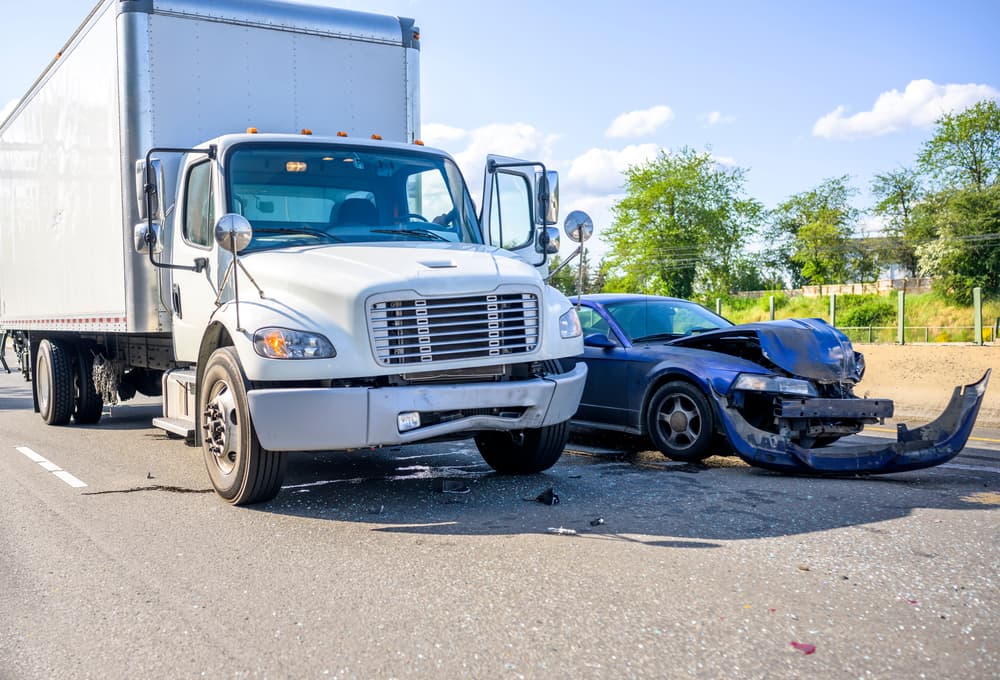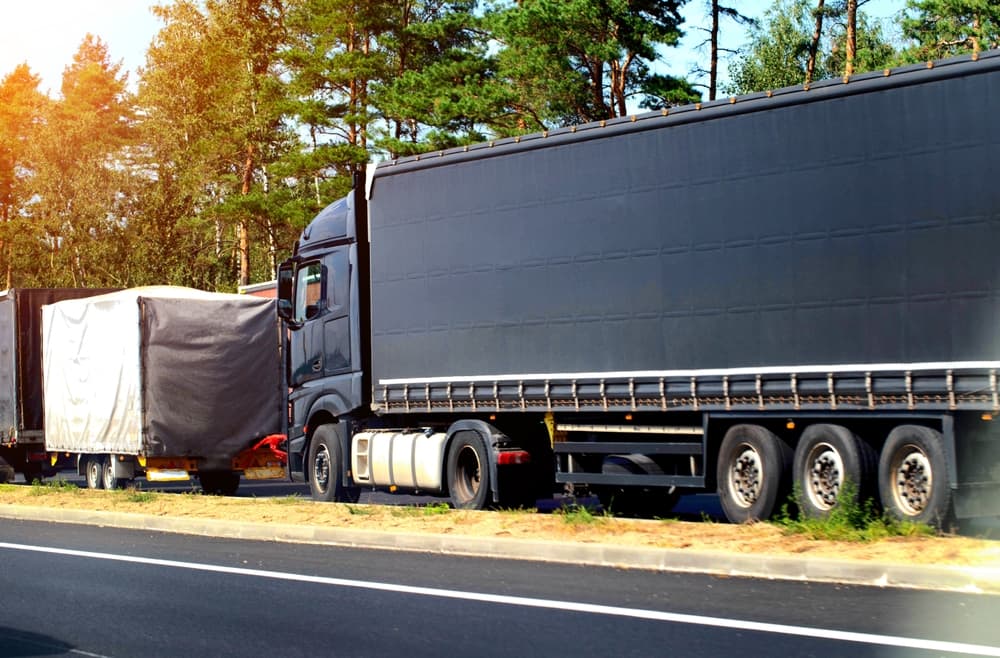Imagine this scene for a moment. You're driving on a busy interstate, maybe returning home after a long day or heading to meet friends. You notice a semi-truck up ahead, its massive size taking up a significant portion of the road. You pass cautiously, feeling the pull of air as you move alongside it. Suddenly, almost without warning, the truck shifts lanes.
Your heart races, your hands tighten around the steering wheel, and you swerve to avoid being hit. Somehow, you manage to avoid an accident this time. But the question nags at you as you drive away, shaken: Why did the truck driver move over when you were clearly there?
This exact scenario, and many variations of it, happens all too often on roads across the country. What causes these terrifying close calls or devastating crashes? A primary factor is truck blind spots.
What Are Truck Blind Spots?
To understand how blind spots work, picture yourself sitting in the driver’s seat of a standard car. You’ve got mirrors on both sides and a rearview mirror to help you see what’s happening behind you. Yet, even with these tools, there’s always a small area where a car could “disappear” from view.
Now, imagine driving a vehicle twenty times the size of your car. Truckers don’t just have small blind spots; they have massive ones that some people call “no-zones.” These are areas around a truck where they can’t see you, even with those large side mirrors. What makes it even more dangerous is that many drivers don’t realize how extensive these no-zones actually are.
For trucks, blind spots exist on all four sides:
- Front blind spot: If you’re driving too closely in front of a truck, the driver may not see your car at all.
- Rear blind spot: Trucks don’t have rearview mirrors like your car does. If you’re right behind a truck, they’re likely unaware you’re there.
- Side blind spots: Trucks have significant blind spots on both sides, especially on the right side, which is notoriously called the “blind side” for a reason.
Drivers are often unaware of these no-zones, which can lead to dangerous decisions on the road. But it’s not just about misunderstanding where the blind spots exist. It’s also about how tiny errors or distractions in those areas can quickly lead to a serious accident.
How Do Blind Spots Cause Accidents?
Truck blind spots and accidents go hand in hand because of one major factor: visibility. If a truck driver doesn’t see you, their decisions can inadvertently place you in harm’s way. Here are some real-world scenarios to explain how this happens:
- Lane Changes Gone Wrong
Picture yourself in a sedan traveling alongside a truck. The truck driver needs to shift lanes to keep up with traffic. They check their mirrors and see what looks like clear space. But you’re cruising in their side blind spot, invisible to them. They start merging, and suddenly, your small vehicle is squeezed between the truck and the barrier or other lane. - Rear-End Collisions in the No-Zone
Following too closely behind a truck puts you directly in the rear blind spot. Say the truck driver needs to suddenly slow down for debris on the road. If you’re in that no-zone, you won’t see the truck’s brake lights until it’s too late to stop yourself. Likewise, the truck driver may not realize you’re there and unintentionally cause a collision. - Turning Mishaps and the “Squeeze”
Trucks often make wide turns, especially when navigating intersections. When a truck swings out to the left before turning right, it creates a wide open space that might seem like an invitation to pass. But if you’re alongside the truck in that gap when the driver starts their turn, your vehicle could be caught between the truck and the curb, leading to devastating results. - Stopping Distance Disasters
Did you know the average truck needs nearly twice the distance to stop compared to a passenger car? If you cut into their front blind spot too closely, they may not see you or have time to slow down effectively. This can end in a terrible rear-end collision.
Why Truck Blind Spots Are Worse Than You Think

When people hear “blind spots,” they tend to assume that mirrors and cameras must make them manageable. But in reality, even with modern technology, these no-zones remain a huge problem. Trucks are enormous, and their blind spots span wide swaths of road where passenger vehicles could disappear entirely. Here are some factors that exacerbate the problem:
- Sheer Size of Trucks
Your average semi-truck is about 70 to 80 feet long and can weigh up to 80,000 pounds when fully loaded. The bigger the vehicle, the larger the blind spots. - Delayed Reaction Time
Truck drivers have to scan more mirrors and account for much more road space than you do. Even with their best efforts, reacting swiftly to vehicles darting in and out of blind spots can be challenging. - Driver Fatigue
Long hours on the road and tight delivery schedules often mean truck drivers are tired, making them more likely to overlook vehicles in no-zones. - Distracted Driving
Everyone knows distracted driving is dangerous. For truckers, even glancing at a GPS or answering a dispatch call could be the split second it takes for someone’s car to fall into their blind spot unnoticed.
Catastrophic Consequences for Victims
When truck accidents occur as a result of blind spots, the injuries are often severe. Trucks are powerful machines, and their size and weight can crush smaller passenger vehicles. Victims frequently suffer life-altering consequences such as:
- Traumatic brain injuries
- Broken bones and fractures
- Spinal cord injuries
- Cuts, burns, and disfigurement
- Emotional trauma and PTSD
What makes it even more devastating is that these accidents are often preventable when proper attention and precautions are taken.
Who Is at Fault in a Blindspot Truck Accident?
Blindspot accidents typically occur because one party was unaware of the other’s presence, but that doesn’t automatically mean both parties share equal blame. Here's an explanation of how fault is often decided in these cases:
Truck Driver Responsibilities
Truck drivers are trained to be aware of their vehicle's blind spots and take extra precautions when making maneuvers like lane changes, turns, or merges. If a truck driver fails to properly check their mirrors, signal their intentions, or drive cautiously in heavy traffic, they may be held liable for the accident. For example:
- If a truck driver merges without ensuring their blind spots are clear, causing a collision, they may be deemed at fault.
- If the driver was distracted, fatigued, or under the influence, this can further strengthen the case against them.
The Role of State Laws and Comparative Negligence
Fault is also often influenced by state liability laws. Some states follow a "modified comparative negligence" rule, which means you can still recover compensation as long as you’re found to be less than a certain percentage at fault. However, the total compensation amount may be reduced based on your percentage of fault. An experienced truck accident lawyer can help you understand how these laws apply to your specific case.
Ultimately, fault in blindspot truck accidents isn’t always clear-cut, which is why gathering evidence and consulting with a truck accident attorney is crucial. They will analyze evidence to build a strong case on your behalf.
Steps to File a Claim After a Truck Accident

Filing a truck accident claim is an essential step in seeking compensation for your injuries,
property damage, and other losses. While the process may seem stressful, breaking it down into clear steps can make it more manageable.
1. Seek Immediate Medical Attention
Your health and safety come first. After the accident, get checked by a medical professional, even if you don’t think your injuries are severe. Some injuries, like whiplash or internal bleeding, may not show symptoms immediately but can worsen over time. Medical records also tend to serve as important evidence in your claim.
2. Report the Accident to the Police
A police report is a key document when filing a claim. Contact law enforcement so they document the accident accurately. It’s also a good idea to request a copy of the report once it’s completed.
3. Notify Your Insurance Company
Many insurance providers require policyholders to report accidents within a certain timeframe. Provide your insurer with basic details of the crash, but stick only to the facts. Avoid admitting fault or speculating about what caused the accident.
4. Identify All Parties Responsible
Truck accidents often involve multiple parties. These could include:
- The truck driver
- The trucking company
- Vehicle maintenance crews
- Manufacturers of faulty parts (e.g., tires or brakes)
A truck accident attorney will investigate all potential sources of liability to maximize your claim.
5. File a Claim with the Trucking Company’s Insurer
Trucking companies and their insurers usually have extensive resources to dispute claims. This is why having legal representation is vital. Your lawyer will communicate directly with the insurance company, submit your claim, and negotiate on your behalf. They can also hold the trucking company accountable if issues like driver fatigue, improper training, or equipment violations contributed to the accident.
6. Start Building Your Truck Accident Case
To ensure your claim is successful, your attorney will need to prove negligence. Establishing this requires evidence, such as:
- The truck driver's logs
- Maintenance records of the truck
- Witness statements
- Expert accident reconstruction reports
Your attorney will ultimately uncover and organize this evidence.
7. Negotiate or File a Lawsuit
Once your claim is filed, the insurance company may try to offer a settlement. While it may be tempting to accept a quick payout, initial settlement offers are often much lower than what you deserve. Work with your attorney to negotiate for fair compensation. If negotiations fail, you may need to file a lawsuit and prepare to go to court.
Why Acting Quickly Matters
Truck accident claims are time-sensitive. Evidence can disappear, memories fade, and there are strict deadlines (known as the statute of limitations) for filing a claim. Acting promptly ensures you have the best chance of recovering fair compensation for your losses.
Filing a claim after a truck accident may seem complex, but having an experienced legal team guiding you through the process ensures your rights are protected and your future is secure.
You Don’t Have to Navigate a Truck Accident Alone

Dealing with the aftermath of a large truck accident tends to feel overwhelming. You might be facing significant medical bills, painful injuries, and questions about how to hold the responsible party accountable. Trucking companies and their insurers often have teams of lawyers working to protect their interests. This is why it’s critical to have someone on your side, fighting for your rights.
A compassionate and experienced truck accident lawyer can help build your case by:
- Gathering evidence like witness testimonies, security footage, and accident reports.
- Analyzing truck driver logs and maintenance records to identify potential negligence.
- Consulting with experts to demonstrate how the accident occurred and who was responsible.
The insurance companies may try to shift blame, delay compensation, or settle for far less than you deserve. But with the right truck accident legal advocate, you can focus on your recovery, knowing your case is in capable hands.
Resolve Your Legal Issues with an Experienced Truck Accident Lawyer Today
Truck accidents caused by blind spots are far too common, but victims shouldn’t have to bear the burden alone. At Abels & Annes, P.C., our legal team has the experience and resources to help you through this challenging time. We’ve helped clients secure millions of dollars in settlements and verdicts, and we will fight tirelessly for you too.
Contact us today, so we can discuss your legal options and the best way to move forward.



